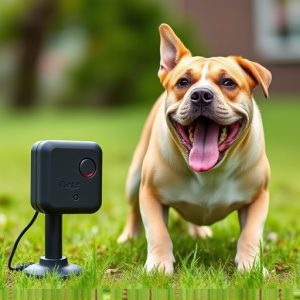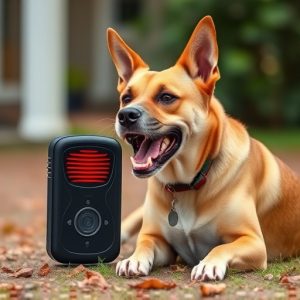Adjusting Sonic Repellent Training Levels for Effective Dog Behavior Correction
Adjusting sonic repellent training levels is crucial for effective dog behavior management. By tailo…….
Adjusting sonic repellent training levels is crucial for effective dog behavior management. By tailoring sonar frequency, volume, and duration based on individual dog sensitivity and behavioral changes, trainers can correct behaviors without causing discomfort. A gradual, cautious approach with regular progress evaluations ensures a customized learning environment that promotes positive behavior modifications while minimizing unintended effects. This strategic method enhances animal behavior management, enabling professionals to modify habits of various species in research and real-world applications.
“Unleash a well-behaved canine companion with the power of sonic dog training, a modern behavioral correction method. This innovative approach uses sound waves to guide your pet’s behavior without traditional punishment. In this comprehensive guide, we’ll explore the principles behind sonic training, from understanding its non-invasive techniques to mastering the art of adjusting sonic repellent training levels. Learn how to identify the right intensity for your dog’s unique needs and effectively modify settings for optimal results.”
- Understanding Sonic Dog Training and Its Principles
- The Role of Adjusting Repellent Training Levels
- Identifying Appropriate Training Intensity for Your Dog
- Techniques to Safely Modify Sonic Training Settings
- Monitoring and Evaluating the Effectiveness of Sonic Correction
Understanding Sonic Dog Training and Its Principles
Sonic dog training, also known as sound-based or ultrasonic training, is a modern approach to behavioral correction that utilizes high-frequency sounds to guide and modify canine behavior. This innovative method involves the use of small devices that emit specific tones, designed to capture a dog’s attention and prompt desired actions without causing harm or discomfort. By adjusting the intensity and frequency of these sounds, trainers can effectively communicate with dogs in a way they understand instinctively.
The principles behind sonic repellent training are based on positive reinforcement and desensitization. The devices emit ultrasonic waves that are inaudible to humans but disruptive to dogs, encouraging them to alter their behavior. As the training progresses, owners can gradually adjust the training levels, increasing the volume or introducing new sounds to refine their dog’s responses. This flexibility allows for a tailored approach, catering to each dog’s unique personality and learning curve.
The Role of Adjusting Repellent Training Levels
In the realm of sonic dog training and behavioral correction, adjusting repellent training levels is a nuanced yet vital aspect that requires careful consideration. As dogs have varying sensitivities to sound, customizing the intensity of sonic repellents ensures effective training without causing discomfort or distress. This fine-tuning involves assessing the dog’s reaction to the current settings and gradually modifying them based on observed behavior changes.
By adjusting the sonar frequency, volume, or duration of the repellent stimulus, trainers can target specific behaviors while minimizing unintended consequences. For instance, lower levels might suffice for correcting minor misbehaviors, while higher settings could be necessary for more persistent issues. Regularly evaluating the dog’s progress and making these adjustments ensures a tailored training approach, fostering a healthier learning environment and ultimately achieving desired behavioral modifications.
Identifying Appropriate Training Intensity for Your Dog
When it comes to sonic dog training and behavioral correction using repellents, finding the right intensity is key to success. Every dog is unique, with varying sensitivities and learning curves, so adjusting the training levels of your sonic repellent is essential. Start by selecting a low setting to ensure the sound is not overwhelming for your pet. Gradually increase the intensity as your dog becomes accustomed to the signal, allowing them to learn and respond without stress.
Overtime, you can fine-tune these settings based on your dog’s progress and individual needs. It’s important to remember that excessive noise can be counterproductive and even harmful to your dog’s hearing or emotional well-being. Therefore, always monitor their reaction and make adjustments accordingly, ensuring a positive training experience that promotes effective behavioral correction.
Techniques to Safely Modify Sonic Training Settings
When adjusting sonic repellent training levels, it’s crucial to do so gradually and with care. Start by increasing or decreasing the volume by small increments until you observe the desired behavior change. Consistently monitor your dog’s reaction; if they show signs of distress or discomfort, immediately lower the setting. The goal is to find the optimal level that prompts desired behavior without causing anxiety.
Additionally, consider using specific training modes offered by sonic devices. Many models have adjustable frequency settings and pulse widths, allowing for more precise corrections. Experimenting with these parameters can help target problematic behaviors more effectively while minimizing any negative impact on your dog’s overall well-being.
Monitoring and Evaluating the Effectiveness of Sonic Correction
Sonic dog training, while an innovative approach to behavioral correction, requires careful consideration and adjustment of repellent training levels. By understanding the principles behind this method and monitoring its effectiveness, owners can ensure safe and positive results for their furry companions. Adjusting the training intensity according to your dog’s needs is key, allowing for a tailored experience that promotes good behavior without causing distress. With proper techniques and ongoing evaluation, sonic correction can be an effective tool in shaping your dog’s behavior, making it a valuable addition to any pet trainer’s arsenal.


